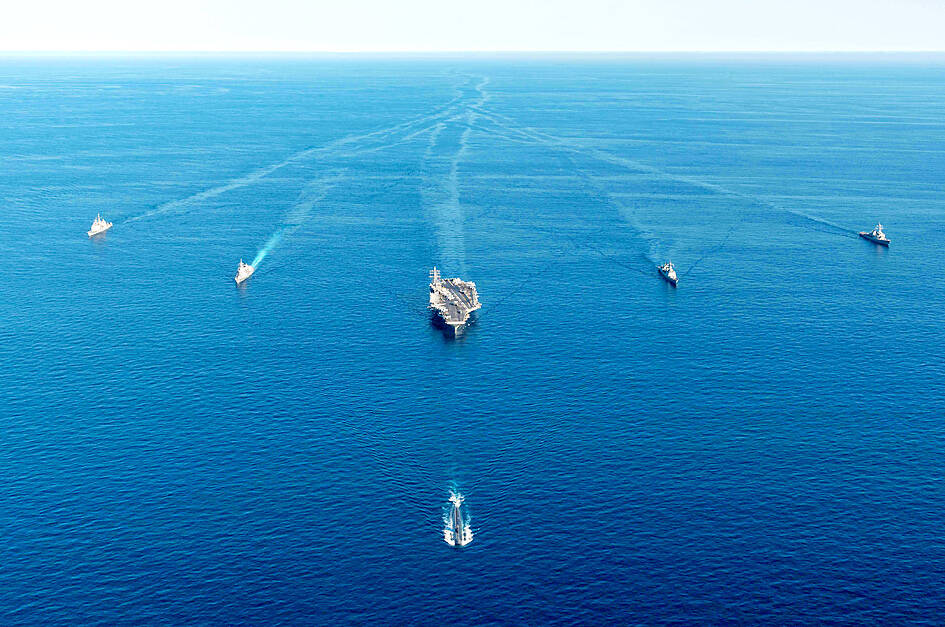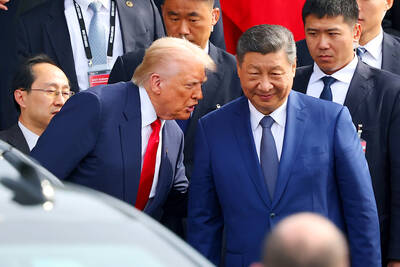South Korean, US and Japanese warships launched their first trilateral anti-submarine drills in five years yesterday, after North Korea renewed missile tests in an apparent response to bilateral training by South Korean and US forces.
Pyongyang’s most recent five missiles launches, the first such tests in a month, also came before and after US Vice President Kamala Harris visited South Korea on Thursday and reaffirmed the “ironclad” US commitment to the security of its Asian allies.
The one-day three-nation training off the Korean Peninsula’s east coast is meant to cope with a North Korean push to advance its ability to fire missiles from submarines, the South Korean navy said in a statement.

Photo: AFP / South Korean Defence Ministry
North Korea has in the past few years been building bigger submarines, including a nuclear-powered one, and testing sophisticated missiles that can be fired from them.
South Korean officials last week said they had detected signs that North Korea was preparing to test-fire a missile from a submarine.
The joint drills involve the nuclear-powered aircraft carrier USS Ronald Reagan, and US, South Korean and Japanese destroyers, the navy statement said.
During the training, the ships were to search and track a US nuclear-powered submarine posing as a North Korean submarine, media reports said.
“We will respond and neutralize any forms of North Korean provocations in an overwhelming and decisive manner,” South Korean navy Captain Cho Chung-ho, commander of his country’s troops who took part in the training, was quoted as saying in the statement.
The training came as South Korea and Japan are looking to mend ties frayed over history and trade disputes.
The two countries together host a total of 80,000 US troops.

CALL FOR SUPPORT: President William Lai called on lawmakers across party lines to ensure the livelihood of Taiwanese and that national security is protected President William Lai (賴清德) yesterday called for bipartisan support for Taiwan’s investment in self-defense capabilities at the christening and launch of two coast guard vessels at CSBC Corp, Taiwan’s (台灣國際造船) shipyard in Kaohsiung. The Taipei (台北) is the fourth and final ship of the Chiayi-class offshore patrol vessels, and the Siraya (西拉雅) is the Coast Guard Administration’s (CGA) first-ever ocean patrol vessel, the government said. The Taipei is the fourth and final ship of the Chiayi-class offshore patrol vessels with a displacement of about 4,000 tonnes, Lai said. This ship class was ordered as a result of former president Tsai Ing-wen’s (蔡英文) 2018

UKRAINE, NVIDIA: The US leader said the subject of Russia’s war had come up ‘very strongly,’ while Jenson Huang was hoping that the conversation was good Chinese President Xi Jinping (習近平) and US President Donald Trump had differing takes following their meeting in Busan, South Korea, yesterday. Xi said that the two sides should complete follow-up work as soon as possible to deliver tangible results that would provide “peace of mind” to China, the US and the rest of the world, while Trump hailed the “great success” of the talks. The two discussed trade, including a deal to reduce tariffs slapped on China for its role in the fentanyl trade, as well as cooperation in ending the war in Ukraine, among other issues, but they did not mention

HOTEL HIRING: An official said that hoteliers could begin hiring migrant workers next year, but must adhere to a rule requiring a NT$2,000 salary hike for Taiwanese The government is to allow the hospitality industry to recruit mid-level migrant workers for housekeeping and three other lines of work after the Executive Yuan yesterday approved a proposal by the Ministry of Labor. A shortage of workers at hotels and accommodation facilities was discussed at a meeting of the legislature’s Transportation Committee. A 2023 survey conducted by the Tourism Administration found that Taiwan’s lodging industry was short of about 6,600 housekeeping and cleaning workers, the agency said in a report to the committee. The shortage of workers in the industry is being studied, the report said. Hotel and Lodging Division Deputy Director Cheng

‘SECRETS’: While saying China would not attack during his presidency, Donald Trump declined to say how Washington would respond if Beijing were to take military action US President Donald Trump said that China would not take military action against Taiwan while he is president, as the Chinese leaders “know the consequences.” Trump made the statement during an interview on CBS’ 60 Minutes program that aired on Sunday, a few days after his meeting with Chinese President Xi Jinping (習近平) in South Korea. “He [Xi] has openly said, and his people have openly said at meetings, ‘we would never do anything while President Trump is president,’ because they know the consequences,” Trump said in the interview. However, he repeatedly declined to say exactly how Washington would respond in